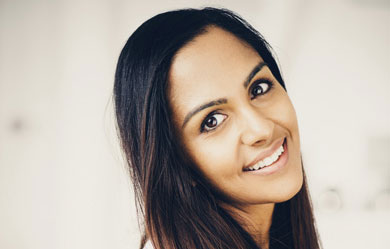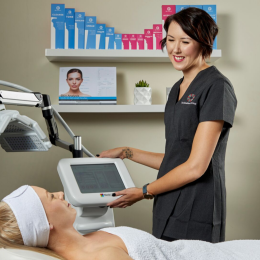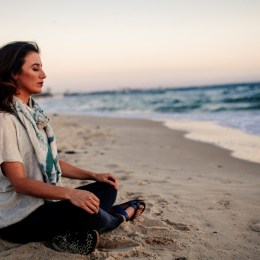
Australia has one of the most racially diverse societies in the world, and with that comes a multitude of skin types and colours.
You would imagine, then, a buoyant industry of skincare products, makeup and clinical treatment protocols tailored to the unique characteristics and concerns of brown skins. You would be wrong.
This gap in the market was a source of immense frustration to erstwhile HR executive Lynn Ross, whose Anglo-Indian skin was troubled by adult acne and subsequent scarring, as well as hyperpigmentation and sunspots.
‘The average skincare product available in Australia is not designed to meet the challenges experienced by those with darker skin,’ she says. ‘And the few that do often contain potentially harmful bleaching and lightening chemical agents and other undesirable ingredients.’
Lynn says her own skin eventually ‘broke down’ a few years ago after using products that exacerbated the conditions they were intended to treat. It was this watershed that led her to create her own range of organic skincare, BrownSkinSecrets, to cater for the unique characteristics of darker complexions.
As a spa or clinic owner, it is important to understand the differences and nuances when treating clients with brown skins, given that they are likely to comprise a significant proportion of your clientele.
The level of pigment that determines the complexion of an individual is dependent on the amount of melanin in skin cells – the more melanin, the deeper/darker the skin tone.
Higher levels of melanin (thus greater inbuilt UV protection than with white skins), the very quality that can keep brown-skinned people looking younger for their age than their white-skinned counterparts, can, on the other hand, leave disfiguring marks from even an ordinary bout of acne.
‘Dark skin is a blessing as it relates to sun damage and ageing,’ says dermatologist Dr Susan Taylor, director of the Skin of Colour Centre in New York.
‘A 50-year-old woman of colour often looks 40, while a white woman of the same age might look 10 years older than her real age. But skin of colour can cause significant problems, as well.’
Without proper care, melanin can permanently mar the skin’s thin protective blanket.
According to the Australian Bureau of Statistic and Census data for 2011, the population of Australia is around 22 million people. Approximately six million of those were born overseas.
A large part of the immigrant population falls under the category of ‘ethnic skin/brown skin’ – that is, the Maori population of New Zealand, India, Southern Italy, Philippines, Malaysia and also the UK, given the large African and Indian population.
The Australian population of Aboriginal and Torres Islanders is reckoned to be upwards of half a million people.
Among the melanin-blamed skin problems in darker-skinned people with Aboriginal and Torres Strait Islander, Pacific islander, African, Hispanic, Middle Eastern, Mediterranean and Asian ancestry:
‘ Susceptibility to sunspots, uneven skin tone and pigmentation. This is because brown skin has higher natural UV protection. And don’t mistakenly assume that your darker skin is a guarantee against skin cancer. Any type of skin – whatever the shade, whatever the texture – is subject to skin cancer without additional, artificial SPF protection. So, use at least an SPF15 sunscreen or moisturiser with sunscreen added.
‘ More prone to acne, pimples and/or oily or dry patches. One of the reasons for this is that brown skin has generally larger pores.
‘ Post-inflammatory hyperpigmentation. Skin damage as minor as a scratch or pimple triggers excess melanin production and can result in dark patches. Without prompt attention, the marks may last for months, even years before they fade.
‘ Hypopigmentation. Burns or other skin trauma leaves lighter areas (ie. hypopigmentation) as unwelcome reminders. This is why practitioners using laser or Iight devices such as IPL and skin peels must have a thorough knowledge of skin types and what treatments can be used safely on each. Skin phototypes IV-VI (ie darker skins) are often contra-indicated for laser or light procedures (including permanent hair reduction) because of the risk of burns and hypopigmentation or scarring. This is where education and training is absolutely essential for anyone operating lasers and IPLs.
‘ Keloids. Injuries or surgical incisions can leave behind large, raised scars.
Keeping skin looking its best depends on picking the right products and getting professional advice about blemishes before they become long-lasting scars.
‘On a cellular level, darker skin heals and ages differently to other skin types,’ Lynn Ross explains. ‘Brown skin ages differently, it heals differently and it should be cared for differently.
‘It is generally thicker than white skin so moisturisers should be light to easily penetrate the skin to work at a cellular level.
‘It can also rebel against the wrong products by developing a discoloration that can linger for months or years. This is often the case with products used to treat acne and other blemishes.’
* This article originally appeared in Spa Australasia magazine, Volume 57, Pages 106-107.



